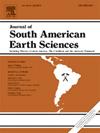Quaternary coastal evolution of the southern edge of the atacama desert: Modeling uplift and wave erosion of pan de azúcar marine terraces (26°S, 70.6°W)
IF 1.5
4区 地球科学
Q3 GEOSCIENCES, MULTIDISCIPLINARY
引用次数: 0
Abstract
The Pan de Azúcar National Park (∼26°S, 70.6°W), located on the southern edge of the Atacama Desert, exhibits for almost 30 km an alongshore morphological segmentation. In this work, we characterized the two contrasting morphological arrangements observed in this area: (1) a wide marine terrace landward backed by a tall coastal cliff, and (2) a sequence of poorly preserved, relatively narrow marine terraces landward backed by a short coastal cliff. Three domains that feature these arrangements are identified. The Central Domain represents the first arrangement, and the Northern and Southern domains represent the second. To understand their formation, we used a simple numerical model that allowed us to better understand the long-term evolution of coastal landscapes in rocky areas. The model gives us first-order insights into the driving processes of the development of coastal morphologies: tectonic history, eustatic sea-level change, and marine erosion. Model results reveal that an initial event of slow subsidence (0.04 mm/yr) between 1 Myr and 400 kyr is likely a necessary condition to develop all contrasting domains. Also, variable uplift rates (0.25–0.35 mm/yr) during the last 400 years have allowed the emersion of dated terraces. With this tectonic history, model results suggest values of marine erosion higher than 1 m2/yr to develop a morphological arrangement such as the Central Domain. Conversely, much lower erosion rates, for instance, 0.25–0.5 m2/yr or less, are necessary to replicate the morphology observed in the Northern and Southern domains. Hence, improving numerical models is a key task in unraveling the modes and temporal and spatial variability of driving and modulating processes.
阿塔卡马沙漠南缘第四纪海岸演变:Pan de azúcar 海洋阶地(南纬 26°,西经 70.6°)的隆起和海浪侵蚀模拟
Pan de Azúcar国家公园(~ 26°S, 70.6°W)位于阿塔卡马沙漠的南部边缘,展示了近30公里的沿岸形态分割。在这项工作中,我们描述了在该地区观察到的两种截然不同的形态安排:(1)一个朝向陆地的宽海洋阶地,背后是一个高高的海岸悬崖;(2)一系列保存较差的、相对狭窄的海洋阶地,背后是一个短的海岸悬崖。确定了以这些安排为特征的三个域。中央域代表第一种排列,南北域代表第二种排列。为了了解它们的形成,我们使用了一个简单的数值模型,使我们能够更好地了解岩石地区沿海景观的长期演变。该模型为我们提供了对海岸形态发展驱动过程的一阶见解:构造历史、海平面上升变化和海洋侵蚀。模型结果表明,1 - 400 kyr之间的初始缓慢沉降(0.04 mm/yr)可能是形成所有对比域的必要条件。此外,在过去的400年里,变化的抬升率(0.25-0.35毫米/年)使得年代久远的阶地得以出现。根据这一构造历史,模型结果表明,海洋侵蚀值高于1 m2/yr,形成了中央区域等形态安排。相反,低得多的侵蚀速率,例如0.25-0.5 m2/年或更低,需要复制在北部和南部区域观察到的形态。因此,改进数值模型是揭示驱动和调制过程的模式和时空变异性的关键任务。
本文章由计算机程序翻译,如有差异,请以英文原文为准。
求助全文
约1分钟内获得全文
求助全文
来源期刊

Journal of South American Earth Sciences
地学-地球科学综合
CiteScore
3.70
自引率
22.20%
发文量
364
审稿时长
6-12 weeks
期刊介绍:
Papers must have a regional appeal and should present work of more than local significance. Research papers dealing with the regional geology of South American cratons and mobile belts, within the following research fields:
-Economic geology, metallogenesis and hydrocarbon genesis and reservoirs.
-Geophysics, geochemistry, volcanology, igneous and metamorphic petrology.
-Tectonics, neo- and seismotectonics and geodynamic modeling.
-Geomorphology, geological hazards, environmental geology, climate change in America and Antarctica, and soil research.
-Stratigraphy, sedimentology, structure and basin evolution.
-Paleontology, paleoecology, paleoclimatology and Quaternary geology.
New developments in already established regional projects and new initiatives dealing with the geology of the continent will be summarized and presented on a regular basis. Short notes, discussions, book reviews and conference and workshop reports will also be included when relevant.
 求助内容:
求助内容: 应助结果提醒方式:
应助结果提醒方式:


